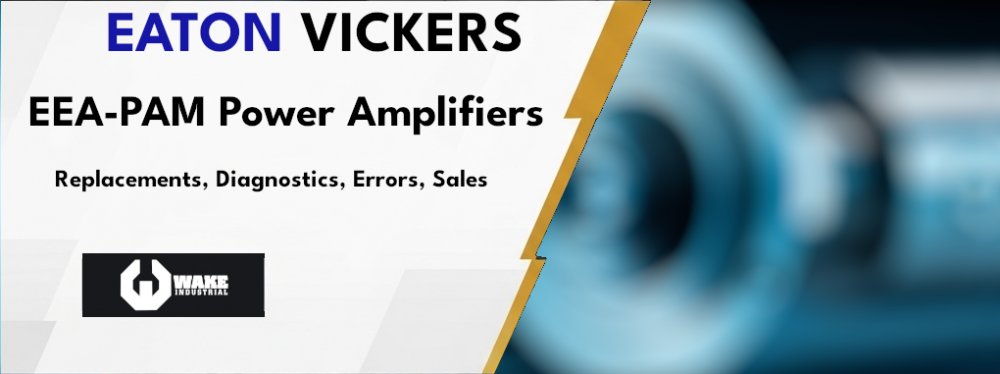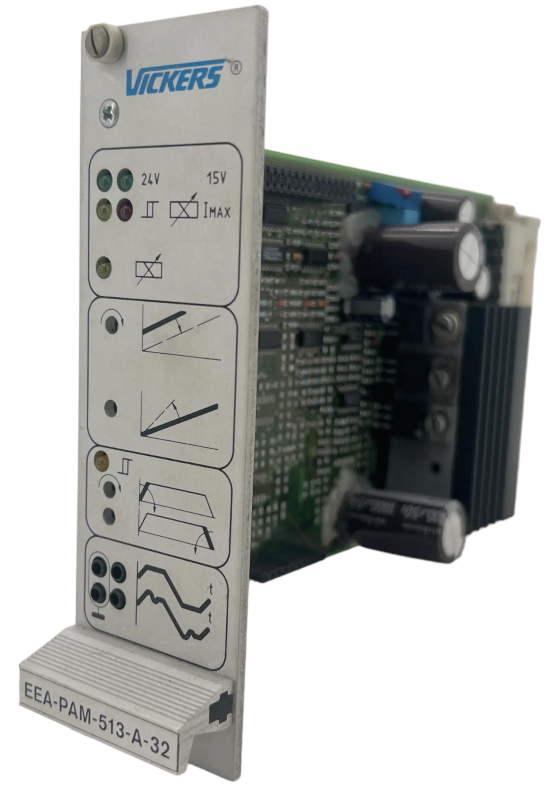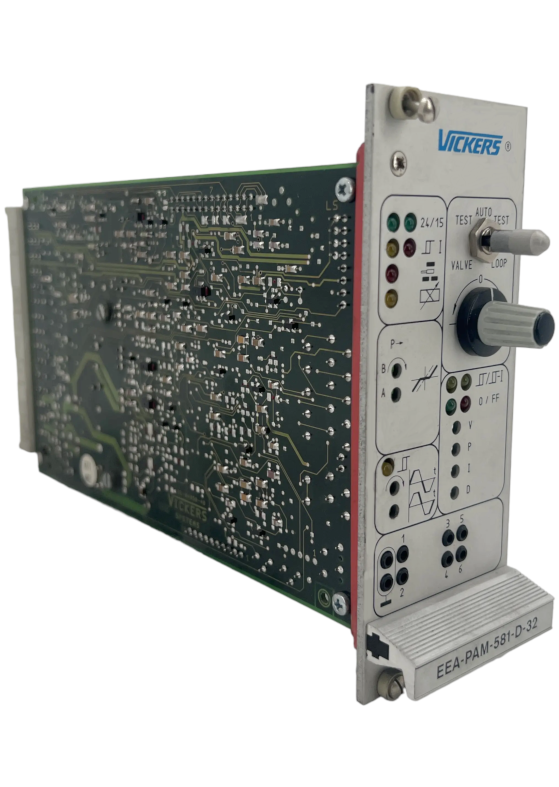
Vickers EEA-PAM Amplifier Cards: Specs, Sales, and Services
Wake Industrial proudly offers a comprehensive range of Vickers EEA-PAM amplifier cards to meet the needs of industrial managers, procurement teams, and engineers. Whether you need to buy a replacement unit, repair a faulty card, or even upgrade your system, Wake Industrial has the expertise and inventory to support you. We carry various models (detailed below) spanning the A, C, and D series of EEA-PAM cards, including popular units like the EEA-PAM-581-D-32 and EEA-PAM-535-A-32. All units are thoroughly tested and backed by our in-house quality standards. (Note: Wake Industrial is not an authorized distributor of Vickers; we specialize in surplus sales and independent repair services.) Minimize your downtime and get your line back up and ready ASAP by contacting Wake Industrial for a quote via the form on the page or by calling 1-919-443-0207.
Vickers EEA-PAM amplifier cards are high-performance electronic modules designed to precisely control Eaton Vickers proportional and servo valves in industrial hydraulic systems. These plug-in cards provide the interface between command signals (from a PLC or motion controller) and hydraulic valve solenoids, translating electrical inputs into accurate hydraulic power control. Built with robust engineering and PID control capabilities in advanced models, EEA-PAM cards help maintain stable pressure and flow, enabling smooth and repeatable motion in heavy machinery. Each card features a user-friendly front panel with status LED indicators and adjustment potentiometers, making it easy to tune performance on-site and monitor a systems status. In short, Vickers EEA-PAM cards offer an all-in-one solution to optimize hydraulic actuator performance while reducing downtime and simplifying troubleshooting.
(Looking for the easy to read technical spec chart? The troubleshooting chart? Click these links to immediately navigate to these charts.)

Industry Applications
Vickers EEA-PAM amplifier cards are widely used across industries that rely on electro-hydraulic control for precise motion and force. These cards integrate seamlessly with Vickers proportional valves to ensure accurate control in a variety of hydraulic applications. Below are some of the key industries and systems where EEA-PAM cards prove indispensable:
Factory Automation and Robotics
Used to control hydraulic actuators on assembly lines, robotic arms, and automated material handling systems, ensuring smooth and coordinated movements in manufacturing plants.
Heavy Industrial Machinery
Integral to hydraulic presses, injection molding machines, metal forming equipment, and stamping machines where precise pressure and position control are required under high loads.
Mobile and Construction Equipment
Employed in excavators, loaders, and other heavy equipment to provide fine control over movements such as boom positioning, steering, and blade actuation.
Aerospace and Defense Systems
Utilized in hydraulic simulation rigs, aircraft test equipment, and military machinery for controlling actuators with high precision and reliability.
Energy and Utilities
Found in hydraulic governor systems for turbines, dam gate controls, and other infrastructure where regulated fluid power is crucial.
Fluid Power Training and R&D
Often used in educational labs and testing facilities to demonstrate proportional valve control and to develop new electro-hydraulic control strategies.
In each of these domains, the EEA-PAM cards help maintain consistent performance of hydraulic systems, providing features like ramped acceleration/deceleration (preventing shocks in machinery), closed-loop feedback for positioning accuracy, and diagnostic LEDs for quick status checks. Their rugged design ensures they can withstand the electrical noise and physical conditions of industrial environments, from factory floors to mobile machinery in the field.

The EEA-PAM-513-A-32 has a power supply Nominal Voltage of 24V DC x 50W. It operates in a temperature range of 0 to 50C.
Technical Specifications
Vickers EEA-PAM amplifier cards share a core set of technical specifications that make them suitable for demanding industrial use. While specific values can vary slightly by model, the following are common characteristics and capabilities found across the EEA-PAM A-14, A-30, A-32, C-32, and D-32 series cards:
- Power Supply: Designed for a nominal 24 V DC supply voltage (with tolerance typically around 18–32 V). An automatic undervoltage shutdown engages if supply falls too low to protect the system. This ensures stable operation even with supply fluctuations, and reverse-polarity protection is built in to prevent damage.
- Input Signal Channels: Each amplifier includes multiple command input channels (usually five inputs, including one inverting input for differential control) to accept a variety of control signals. These support standard ±10 V analog voltage commands and 0 to 20 mA current command signals for broad compatibility with PLCs and motion controllers. The inputs can be configured for features like preset positions or variable profiles, giving flexibility in complex control.
- Output Drive & Capacity: The amplifier outputs are tailored to drive proportional valve solenoids with high precision. The typical maximum solenoid drive current is around 1.6 A per coil, sufficient for most Eaton Vickers valve coils (e.g. size 5 valves with H-coils). The cards employ pulse-width modulated (PWM) power output stages for efficiency and include short-circuit/overload protection with automatic reset – if a coil is overcurrent or wiring fault occurs, the amplifier limits output and recovers automatically once the condition is cleared. This protects both the amplifier and the valve coil.
- Closed-Loop Feedback Support: Many EEA-PAM cards are capable of closed-loop operation. They interface with valve spool position sensors (LVDTs) or feedback transducers to maintain precise control over the valve position or output flow/pressure. For example, the front panel monitor points allow reading the LVDT spool position signal or solenoid current directly, enabling easy calibration of null position and feedback tuning. Advanced D-series models even integrate an internal PID module for closed-loop control, so they can automatically correct for errors and achieve the commanded position/pressure with minimal deviation. This level of control can eliminate the need for a second card in applications that previously required one amplifier for command and another for feedback control.
- Ramp Generator & Dynamic Response: All models include some form of ramp function to smoothly ramp command signals up or down, preventing abrupt changes in actuator movement. Standard A-series cards provide adjustable ramp time via potentiometers on the front panel. Higher-end C and D series expand on this with a 4-quadrant ramp generator, meaning you can set separate ramp rates for accelerating vs. decelerating in both directions of motion. Ramp times typically range from very quick (~50 ms) to slow (~5 seconds), giving ample flexibility to tune the responsiveness of your hydraulic system. This is crucial for applications that need a soft-start or stop to avoid pressure spikes and mechanical stress.
- Front Panel Indicators & Adjustments: Each EEA-PAM card is equipped with a front panel that greatly simplifies operation and maintenance. LED indicators are provided for supply power (24V OK and internal ±15V logic supply), for output enable status, for ramp active, and for fault conditions such as LVDT failure or output overload. These LEDs give maintenance personnel instant insight into the card’s status. In addition, multi-turn potentiometers on the front panel allow fine adjustment of parameters like gain, bias (zero offset), and ramp times, without needing external tools or software. Monitor test points correspond to key signals – for instance, command input level, spool feedback, and solenoid drive current – so technicians can measure voltages to diagnose and tune system performance. All units are also safeguarded against electrical surges and noise, featuring filtering and compliance with EMC standards for industrial electronics. Moreover, every amplifier card is convection cooled (no fans are required) and housed in a standardized Eurocard form factor for easy insertion into card racks or enclosures.
This EEA-PAM-581-D-32 Card is For Proportional Valve KHDG5V-5/7/8 and has a Power (Input) Supply of 24V DC.

Popular Available Models
Wake Industrial supports a variety of Vickers EEA-PAM amplifier card models, including legacy versions and the latest series. Below is an overview of the available models that we can supply, repair, or replace. Each model is engineered for specific valve types or performance requirements, but all share the quality and reliability of the EEA-PAM family:
- EEA-PAM-118-A-30: A classic A-series amplifier card (30-series design). This unit is known for its ease of tuning on site – front-facing adjustments and monitors make it simple to dial in optimal settings. It operates on 24V DC and is suitable for smaller proportional valves or single-solenoid applications. Despite being an older generation, the 118-A-30 includes essential protection and can be quickly adapted to a variety of hydraulic setups.
- EEA-PAM-520-A-14: An A-series amplifier from the 14-series lineup, notable for its dual-channel design for multi-coil or two-valve control. The 520-A-14 supports 0–10V and 0–20 mA inputs and provides two independent outputs, which is ideal for driving two proportional valves from one card or controlling a two-stage valve (pilot and main stage) simultaneously. It retains all standard features like ramp adjustment and feedback monitoring, in a slightly more compact form factor.
- EEA-PAM-513-A-32: A foundational model in the A-32 series, the 513-A-32 is designed for proportional directional valves in the mid-size range (such as Vickers KDG4V-3 or similar). It offers the full complement of five input channels and LED status indicators of the A-32 series and drives valve solenoids with up to ~1.5 A of current. This model is often used when a reliable open-loop control of flow or pressure is needed, with the ability to monitor spool position via the front panel if the valve is so equipped.
- EEA-PAM-525-A-32: A popular A-32 series card, the 525-A-32 is configured to work with Vickers KDG4V-5 proportional valves (H-coil type) and related models. It runs on a nominal 24 V DC supply at about 50 W capacity, providing ample power for larger solenoids. This unit features automatic shut-down below ~18 V and can drive up to 1.6 A, matching the requirements of many high-flow directional valves. The EEA-PAM-525-A-32 includes built-in automatic reset for overloads and dither control to improve valve hysteresis, ensuring smooth operation of the hydraulic actuator.
- EEA-PAM-535-A-32: This A-32 series model is targeted for use with Vickers KFD/TG4V-5 proportional valves. Like others in its series, it operates on 24 VDC and provides up to 50 W output to the solenoids, with all standard protection. The “535” indicates a revision or option set tailored for certain valve dynamics (for instance, different dither frequency or gain settings out of the box). The 535-A-32 offers reliable open-loop control and can be easily upgraded or replaced one-to-one with newer units if needed, thanks to its standardized pin configuration and form factor.
- EEA-PAM-581-A-32: As one of the highest-numbered A-32 series cards, the 581-A-32 represents a high-performance amplifier for large or particularly sensitive proportional valves. It has the same 24V supply and 0-10V/4-20mA input compatibility but is often paired with valves requiring finer control resolution or those equipped with LVDT feedback for closed-loop control. The 581-A-32 excels in applications where stability and precision are paramount, offering extremely low output drift and high signal fidelity. Many users deploy this card in systems with advanced performance demands, knowing it can be easily adjusted and monitored to fine-tune the hydraulic response.
- EEA-PAM-535-C-32: A C-32 series amplifier card that builds upon the A-series foundation with additional control features. The 535-C-32 includes a 4-input demand module and a 4-ramp function generator with quadrant detection. In practical terms, this means the card can accept up to four preset command inputs (selectable via 24V logic signals) and can apply different ramp profiles depending on the direction of movement (accelerating vs decelerating in either direction). It retains all the standard protections and 24V operating power of the 535 lines. This model is a great choice for more complex motion profiles or where multiple operating modes (speeds or positions) need to be toggled on the fly.
- EEA-PAM-568-C-32: Another member of the C-32 series, the 568-C-32 is engineered for controlling high-flow proportional valves that might be used in heavy machinery or large hydraulic systems. It carries forward the advanced features of the C series – including independent accel/decel ramp adjustments and multiple command presets – ensuring that even a large valve can be tamed for precise control. Typically, the 568-C-32 would be paired with valves in the same numeric family (e.g., DG5V-7 or larger) and is known for its robust output stage and stable performance in strenuous applications such as steel mill hydraulics or large press controls.
- EEA-PAM-581-D-32: A flagship model in the D-32 series, the 581-D-32 is a dual-function amplifier with integrated PID control capabilities. This card can effectively replace two conventional amplifiers by handling both the command input processing and the closed-loop feedback control on a single board. Key highlights of the 581-D-32 include an integral PID module that provides a feed-forward control option, allowing for improved response and accuracy. It also features ramped command inputs and the ability to separately tune acceleration and deceleration phases under closed-loop operation. A built-in self-test function and DIP switch-configurable settings make it easier to commission. The EEA-PAM-581-D-32 is intended for use with high-performance servo valves where precision and dynamic response are critical. If your system requires the utmost in control sophistication – such as synchronized hydraulic axes or pressure/position hybrid control – this D-series card delivers the advanced functionality needed.
If you do not see your specific EEA-PAM model listed above, contact us at 1-919-443-0207 or at sales@wakeindustrial.com!

Services – Repair, Replacement, Refurbishment & Surplus Buying
One of Wake Industrial’s strengths is our comprehensive service offerings for Vickers EEA-PAM cards. Industrial operations can’t afford long downtimes, so we’ve structured our services to keep your hydraulic systems running with minimal interruption. Here’s how we support our customers at each stage of the product lifecycle:
- Expert Repair: If your Vickers amplifier card is malfunctioning – for example, if it’s no longer driving the valve properly, or indicating a fault – our technicians can diagnose and repair the unit to get you back up and running. After repair, each card undergoes rigorous testing on appropriate test stands or with actual valves to verify proper operation under load. Our repair service is both fast and reliable, saving you the cost of full replacement and extending the life of your equipment.
- Direct Replacement: For cases where you need an immediate solution, or a repair is not feasible, Wake Industrial offers replacement units from our inventory of surplus and refurbished EEA-PAM cards. You can purchase the exact model you need (or an equivalent compatible unit), fully tested and ready to install. All replacement amplifier cards come with a warranty to guarantee functionality and give you peace of mind.
- Refurbishment & Reconditioning: If your amplifier card is aging but not outright broken, consider our refurbishment service. We will clean, inspect, and recondition the card, proactively replacing aging components and recalibrating the unit to factory specifications. The card will be calibrated for correct bias, gain, and dither, and all functions will be verified. Refurbished cards often perform like new and can add years of additional service life to legacy equipment. This service is ideal during scheduled maintenance periods – send in your cards for a tune-up and avoid unexpected failures in the future.
- Surplus Buy-Back: Do you have extra or unused Vickers EEA-PAM cards in storage? Wake Industrial is interested in buying your surplus equipment. We purchase used, surplus, or obsolete amplifier cards and other industrial electronics, providing you with fair market value. Our buy-back program helps you recover value from idle assets and supports the sustainability of industrial supply by recirculating components. If you’re upgrading systems or decommissioning machinery, let us know what Vickers cards you have available – we’ll make the process easy with quick evaluation and payment. Those surplus cards will be refurbished and added to our stock to help other customers in need of hard-to-find models.
By offering these four pillars of service – repair, replacement, refurbishment, and surplus purchasing – Wake Industrial is a one-stop solution for all your Vickers amplifier card needs. Our team’s in-depth knowledge of the EEA-PAM series means you can rely on us for accurate support and information. We maintain documentation and test fixtures for the EEA-PAM cards to ensure each service is done correctly and efficiently. In every case, our goal is to minimize your downtime and provide cost-effective options, whether that’s fixing your unit or providing a high-quality replacement.
Ready to get your hydraulic system back on track or upgrade to a more reliable solution? Contact Wake Industrial today for any inquiries regarding Vickers EEA-PAM amplifier cards. Our knowledgeable staff will assist you in finding the right model, provide a fast quote for purchase, or guide you through the repair/refurbishment process. We pride ourselves on quick response and customer satisfaction – in fact, most quote requests are answered within minutes. Don’t let a faulty amplifier card slow down your production or project: call us at 1-919-443-0207, email sales@wakeindustrial.com, or use the quote form above to discuss your needs. Whether you’re looking to buy a surplus Vickers EEA-PAM card, schedule a repair service, or sell us your spare units, we are here to help. Empower your operations with reliable hydraulic control – reach out to Wake Industrial today and keep your machinery running at peak performance!
(As a bonus, we've added in a small chart of common Vickers Eaton EEA-PAM Amplifier Controller Card troubleshooting solutions along with a truncated view of the card specs! )
| Symptom/Indicator | Troubleshooting Step |
|---|---|
| 1. No power LEDs illuminated on front panel | • Verify 24 V DC supply is present at the card’s power pins (nominal 18–32 V).• Check for blown fuses or tripped circuit breakers supplying the card rack.• Confirm correct polarity at the supply terminals. |
| 2. 24 V OK LED on, but +15 V logic LED off | • Measure the internal logic supply voltage at the Vlogic test point (should be approximately ±15 V).• If absent, suspect a failed internal regulator or protection diode. Replace regulator or card. |
| 3. Output Enable LED off (card not driving solenoids) | • Check that the “Enable” input (often a 24 V logic signal) is asserted.• If using dual‐channel models, verify each channel’s enable line.• Ensure no front-panel “Fault Reset” button is engaged. |
| 4. Ramp LED flashing repeatedly | • Inspect front-panel ramp potentiometers for proper adjustment (turn full CCW then CW to re-tune).• If ramp time set to very long, try reducing to a moderate setting (e.g. 100 ms–500 ms).• Check input command signal for noise spikes causing ramp re‐triggers. |
| 5. Output fault LED lit (overcurrent/short‐circuit) | • Disconnect solenoid coil and measure coil resistance (ungrounded short or open coil can cause fault).• If coil OK, measure output pins for short to ground/voltage.• Once corrected, allow automatic reset or cycle power to clear fault. |
| 6. Valve not moving despite valid command input (open‐loop) | • Measure command input voltage at the “Command” test point (should match PLC output ±10 V or 4–20 mA loop).• If command present, measure drive current at the “Iout” test point to confirm card is sourcing current.• If no current, suspect failed output stage or blown driver transistor—send card for repair. |
| 7. Erratic valve movement or hunting (closed‐loop card) | • Inspect LVDT feedback cable connection; confirm proper wiring polarity (± feedback leads).• Measure LVDT reference voltage at feedback test point (should be stable ±5 V).• Verify PID gain pots are not set to extremes; back off gain to a mid‐range value and re‐tune. |
| 8. No response on one of dual‐channels (A-14 or similar) | • Swap the “Command” input cable between Channel 1 and Channel 2 to see if issue follows cable or stays on channel.• Exchange output connectors (solenoid leads) between channels to isolate if the problem is in the card or the valve coil. |
| 9. Excessive heat on card or frequent thermal shutdown | • Confirm proper airflow in the card rack; ensure no dust blocking convection.<br>• Check ambient temperature; if >50 °C, consider relocating to cooler environment or adding additional cooling.• Measure ambient and card-surface temperatures; if card surface >85 °C, suspect compromised internal components—consider refurbishment. |
| 10. Fault LED lit on startup (self‐test failure) | • Power-cycle the card. If fault persists, scroll through front-panel DIP switch settings for correct configuration (especially on D-series models).• Inspect for bent or damaged pins on the card-edge connector that may cause improper seating or open-circuit detection.• If fault continues, send the card to a qualified repair facility for component-level diagnostics. |
EEA-PAM Power Amplifiers Technical Specs
| Model | Series | Supply Voltage | Command Inputs | Output Drive Current | Feedback Support | Ramp Function | Special Features |
|---|---|---|---|---|---|---|---|
| EEA-PAM-118-A-30 | A-30 | 24 V DC (18–32 V) | ±10 V / 0–20 mA (5 inputs) | Up to 1.5 A | Open-loop only (monitor spool feedback via front panel) | Adjustable accel/decel via front-panel potentiometers | Traditional A-series design; front-panel LEDs for power, fault; banana-jack test points; reverse-polarity protection |
| EEA-PAM-520-A-14 | A-14 | 24 V DC (18–32 V) | ±10 V / 0–20 mA (2 independent channels) | Up to 1.5 A per channel | Open-loop (dual-channel valve control) | Adjustable accel/decel via front-panel potentiometers | Dual-channel output for two valves or two-stage valve; front LEDs, banana-jack monitors, overload protection |
| EEA-PAM-513-A-32 | A-32 | 24 V DC (18–32 V) | ±10 V / 0–20 mA (5 inputs) | ~1.5 A | Optional spool feedback (LVDT) | Adjustable accel/decel via front-panel potentiometers | Front-panel LEDs indicate power, ramp, fault; monitor points for command, feedback, current; PWM output stage |
| EEA-PAM-525-A-32 | A-32 | 24 V DC (18–32 V) | ±10 V / 0–20 mA (5 inputs) | Up to 1.6 A | Optional spool feedback (LVDT) | Adjustable accel/decel via front-panel potentiometers | Built-in automatic shut-down below ~18 V; overload/reset protection; dither control for improved valve response |
| EEA-PAM-535-A-32 | A-32 | 24 V DC (18–32 V) | ±10 V / 0–20 mA (5 inputs) | Up to 1.6 A | Optional spool feedback (LVDT) | Adjustable accel/decel via front-panel potentiometers | Optimized for KFD/TG4V-5 proportional valves; standard A-32 protections and LEDs |
| EEA-PAM-581-A-32 | A-32 | 24 V DC (18–32 V) | ±10 V / 0–20 mA (5 inputs) | Up to 1.6 A | Closed-loop capable (LVDT feedback) | Adjustable accel/decel via front-panel potentiometers | High-precision output; low drift; suited for fine-control valve applications; front-panel tuning and diagnostics |
| EEA-PAM-535-C-32 | C-32 | 24 V DC (18–32 V) | ±10 V / 0–20 mA (4 presets + 1 analog) | Up to 1.6 A | Optional spool feedback (LVDT) | 4-quadrant ramp (independent accel/decel in both directions) | 4 preset command inputs selectable via logic; advanced ramp shaping |
| EEA-PAM-568-C-32 | C-32 | 24 V DC (18–32 V) | ±10 V / 0–20 mA (4 presets + 1 analog) | Up to 1.6 A | Closed-loop capable (LVDT feedback) | 4-quadrant ramp (independent accel/decel in both directions) | Designed for high-flow valves; robust output stage; multiple ramp profiles |
| EEA-PAM-581-D-32 | D-32 | 24 V DC (18–32 V) | ±10 V / 0–20 mA (analog) | Up to 1.6 A | Integrated PID closed-loop (LVDT feedback) | Ramp included with separate accel/decel tuning under closed-loop | Built-in PID module with feed-forward option; self-test diagnostics; DIP-switch configurable settings; replaces two cards |











